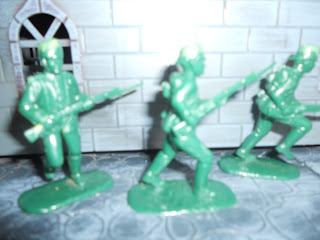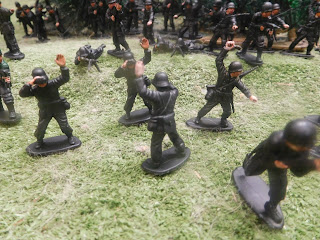Making Resin Figures From Gelatin & Glycerine Molds.
WARNING: Don't use these molds with molten metal!
Several posts back I mentioned I was experimenting with molds made from glycerin and gelatin. The reason I was attracted to this was the materials for the molds could be had from the supermarket and were not hugely expensive. I got the glycerin in bulk from Amazon. The resin was not so cheap, but I bought two big bulk bottles of parts A and B also from Amazon. (I kept my membership of Amazon Prime videos, even though I don't watch it that much, in order to keep the free postage for Amazon products in Australia).
The other reason was I wanted to make copies of figures I had only a limited number of and also, especially rare figures. I could then, additionally, convert the copies.
Below are some resin copies of an ElastoWit figure. The figure at left is unaltered. The one at right has been given a metal spiked helmet. In some earlier posts I made 18th century style figures from these, one with tricorne.
Below: The central figure is the original Airfix Space Warrior undercoated. Either side are two copies. The one at left did not come out so well as he lost the end of his weapon.
below is a copy of a Speedwell native. His right arm and horn did not come out so I'll build those up with putty.
below is the Devil Girl from Mars, copied from ElastoWit. The right-hand figure lost her right arm, so I gave her one from a cheapo modern infantryman. He had a shotgun which I cut down into a pistol. I am thinking of carving down, a little, the shoulder of the new arm join.
Below is an old Hong Kong figure which I think is a copy of Timpo. The original has a strange but endearing, minimalist color scheme. The copy came out really well.
I wanted more grenadiers in miter caps so made a copy of this Marx figure. Figures like this are easier to do because the arms are by the sides. I did want to do the Chabens one, but it would have been harder. The original was actually painted when I covered it with gelatin/glycerin goop, but the paint came off only on a small part of the stand. Only the pompom did not come out, easily fixed with some putty or the end of a mapping pin.
The Airfix robot looking Space Samurai Warrior looks cool, so it got the treatment. On extraction from the mold the original figure had a broken helmet wing which I Super Glued back on. that is the tradeoff; if a figure has brittle extremities they might brake on extraction. The copy was very good except the end of the sword did not come out and the very tips of the helmet wings, so I'll build up the sword with putty over the inserted wire.
Below is the mold. it looks like petrified honey. You could actually, in theory, eat it without too much ill effect except for any resin residue you might consume!
The process of making the molds involves mixing roughly equal parts of water, gelatin and glycerin. The gelatin is melted in hot water and then the contents mixed and heated in a microwave or saucepan. You can cool it in the fridge but don't leave it too long or it will coagulate and must be heated again.
Glue or Bluetack the figure to the bottom, middle, of a plastic or paper cup and pour in the partially cooled mixture to cover it by a few inches, the more the better. I collect old Maccas cups and cut them down. Super Glue holds a figure well but don't use too much or it will be hard to remove the figure. Blue tack is safer for the figure but does not hold it as securely.
In a few hours the substance will firm up. Just test it by poking it with your finger. It will be firmer than a flavored jelly. You can then cut the cup away with your craft knife. Next carefully cut down each side from the base of the figure. Where the figure's stand was will be the pour hole. Don't cut right down but aim to leave the mold joined above the head of the figure so that there is less chance of the resin leaking out.
You will need to cut then separate a little and cut a bit more until you reach the figure. It is almost like performing surgery, cutting through layers of fat. You can also cut between the legs and any other wedges to assist figure removal. When you have cut the figure free gently pull it out. Check if you think you need extra channels to extremities such as swords and gun barrels and these are easy to cut out. They also allow air to escape and assist the flow of the resin. You are ready to pour in the resin.
The resin needs to be measured and mixed in two parts as exactly as possible. I usually use disposable latex gloves as liquid resin feels unpleasant and is somewhat hard to remove from skin.
Tape the mold tightly together with paper tape. Elastic bands can also be used. Pour in the mix. If you buy syringes plungers, you can also shoot the mix into the cavity, but the plunger will have to be replaced, just about each time so I don't use them. Give the mold a few taps to get the mix to go to the bottom.
Generally, you should allow at least 24 hours for the resin to set but I have removed figures earlier, but it is risky as extremities might break off. In fact, longer than 24 hours is even better.
Even allowing a fair amount of time the figure will be slightly soft, but it will harden up in another day or two.
The mold can be reused if it was not damaged in the extraction but eventually it will deteriorate. Usually, I don't get more than three good figures, but some molds have given me about six figures, some one and occasionally none!
Once the mold entirely spits into two halves it is harder to prevent leakage. In any case place the molds in a shallow box lid or something to prevent having resin everywhere.
The good news is you can melt down the molds in your microwave or saucepan and make new ones!
I am making a few extra figures to complete regiments or to create interesting variations on figures. If an arm does not come out it is not a huge deal as I add a new one and make a new pose.
It is a slow process if you want to create twenty odd figures. For mass production other types of molds where you can use metal probably works better. This is a recent experience for me to use resin. previously I collected old pewter cups and melted them down to pour into molds I bought or was given.
There are videos on You Tube about making such molds.




















Comments
Post a Comment